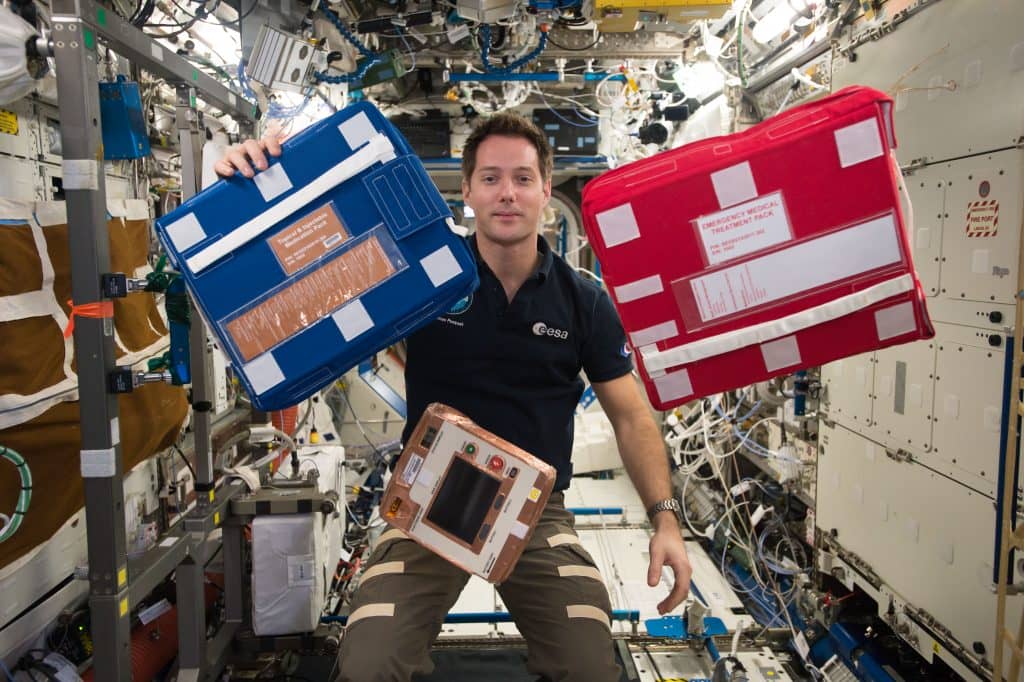A space station is the size of a large vehicle, but it needs to be equipped with the facilities of a city, on a smaller scale. Managing food supplies, clothes, daily washing, hygiene, and tasks of such sort are way more complicated out there. That one thing the space station can not be equipped with is a fully functional medical center. Have you ever heard of a medical doctor being a part of the crew?
The astronauts are medically trained to eliminate the need of sending a doctor along with the crew. While this kind of training is enough for the simpler missions to the low earth orbit or the moon, but it is certainly not sufficient for the dangerous Mars missions that NASA is planning. The medical supplies onboard are limited, and so is the training of the astronauts. In the event of a medical emergency on a crewed Mars mission, even an experienced doctor would have a hard time handling the situation.
The astronauts could break bones, develop blood clots, or have to deal with countless other medical problems. Some people in isolated environments have been able to deal with medical emergencies in a great way. A physician, Jerri Nielsen, working at South Pole’s scientific station in 1999, identified and cured her own breast cancer by conferencing with doctors in the US before she was airlifted for better medical care.
Astronauts need to be able to deal with situations like these as “During these long duration flights, the estimated risk of severe medical and surgical events, as well as the risk of loss of crew life are significant. The exposure to the space environment itself disturbs most physiological systems and can precipitate the onset of space-specific illnesses, such as cardiovascular deconditioning, acute radiation syndrome, hypobaric decompression sickness and osteoporotic fractures,” explained a consultant in intensive care and anesthesia at London’s Charing Cross Hospita, Mathieu Komorowski.
The microgravity environment of space weakens the bones over longer durations of time, potentially causing osteoporotic fractures. The extra radiation exposure in space may also become a cause of unexpected illnesses.
Komorowski has extensive experience with medical emergencies in isolated environments and also served as the on-site doctor for a two-week mission to Mars Desert Research Station (MDRS) in Utah. He conducted a medical study on site as medical procedures were simulated and the crew was taught to insert tubes in a mannequin. This study was published in Extreme Physiology & Medicine in 2014. Even if there was a doctor on the Mars trip, the entire crew needs to be able to handle medical emergencies, in case the physician himself gets sick.
While the basic medical training of the entire group is essential, it certainly is not sufficient. The team could communicate with the doctors on earth for conferencing, but the communication between the two planets lags by a minute, thus rendering emergency conferencing largely ineffective. Prevention steps like matching crew members by blood type and on-demand 3D printing could deal with a lot of problems.
It is important to be careful about using the resources on medical procedures on a person where they are not likely to survive. “During future space exploration missions, the crew must prepare for non-survivable illnesses or injuries that will exceed their limited treatment capability, ” said Komorowski.
Something as simple as cardiopulmonary resuscitation (CPR) is quite complicated when in space. In the microgravity environment, you can not use your body weight, and the medical equipment is also limited. The tests of CPR techniques in simulated space habitats by Jochen Hinkelbein suggest the “handstand technique” for effective CPR in space or the alternative of wrapping the legs around the patient (Evetts-Russomano method) during compressions could make the procedure successful.
Executive senior physician of anaesthesiology and intensive care at the University Hospital of Cologne in Germany who worked on the research said, “Since astronauts are selected carefully, are usually young, and are intensively observed before and during their training, relevant medical problems are, fortunately, rare in space. However, in the context of future long-term missions, for example to Mars, with durations of several years, the risk for severe medical problems is significantly higher. Therefore, there is also a substantial risk of a cardiac arrest in space requiring CPR.”
The Euro Anaesthesia Congress held between June 3 to June 5 in Geneva, Switzerland discussed the aspects of emergency medicine in space.
Source: Seeker

